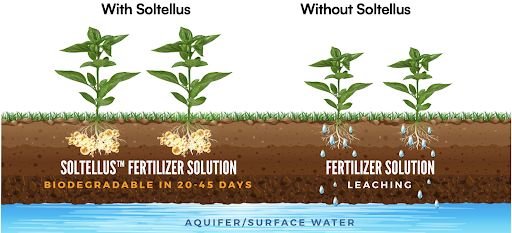
How to Optimize Fertilizer Efficiency
How to Increase Crop Yield & Reduce Fertilizer Loss
October 26, 2023
4 minutes
Agronomy
By Clint Hoffman
Download Free Agronomy GuideHow to Optimize Fertilizer Efficiency
It’s true that water is essential to healthy crops and high yields. Without rainfall and irrigation, crops cannot survive, nevermind efficiently utilize an application of fertilizer. However, water also dissolves fertilizers and is the main culprit for fertilizer loss. Soil continuously loses nutrients through two unavoidable water processes: runoff and leaching.
- Runoff: Rain and irrigation water can carry nutrients laterally (along the topography of the soil’s surface) and away from the intended application area.
- Leaching: Water sinking vertically through the soil column can carry dissolved nutrients along with it, down into groundwater.
Fertilizers are intended to support gradual growth throughout the life cycle of the crop. When minerals and nutrients like nitrogen are drained from the root zone before they can be used by crops, they’re not just wasted — they effectively become contaminants that lead to proliferation of harmful algal blooms and eutrophication of water supplies.
Low Fertilizer Efficiency Has High Costs
Fertilizer loss from runoff and leaching has a severe annual impact on ROI across all major cropping systems. It promotes over-application of fertilizer (to account for loss), requires more work, increases material costs, damages the environment, and reduces yield. In a world where some regions have seen fertilizer prices go up more than 40%, few farmers are happy to buy extra fertilizer just to watch it wash away.
It’s typical for up to a third of fertilizer to go unused by the crop. We know this from published data on nitrogen use efficiency (NUE) over the last 50 years. NUE measures the average ratio between nitrogen inputs and outputs for each country’s cropping systems. Lower numbers are bad; an NUE of 40% would mean that only 40% of the nitrogen farmers put into the system (with fertilizer) can be found in the final crop.
As of the latest data, the U.S. averages 71.61% — not absolutely terrible, but a worse ratio than France, Ireland, Hungary, Austria, Haiti, Indonesia, Ethiopia, Iraq, and many others. This means almost 30% of the nitrogen we apply to our crops is never taken up by them. Instead, it leaks into the natural environment, fertilizing rivers and lakes, upsetting ecosystems, and causing biodiversity loss.
Use Soltellus™ Polymers to Increase Yield & Leave Nothing Behind
The bioengineering minds at Lygos have launched Soltellus™. This multifunctional polymer:
- Makes nutrients available when crops need them
- Keeps nutrients where crops can use them.
Soltellus is a biodegradable and water-soluble polyaspartate product that breaks down into aspartic acid, an amino acid that soil microbes can use as a food source.
Soltellus helps to reduce leaching by binding to the fertilizer and soil particles, holding them in the root zone. As it slowly degrades over 20-45 days, it releases bound (chelated) nutrients over time for uptake by crops.

The Soltellus polyaspartate polymer has been proven to boost nutrient uptake, promote soil health, and improve water quality — all with a reduced environmental impact.
- Increases Crop Yields: From corn to wheat, rice, tomatoes, and cotton, polyaspartate applications increase yields anywhere from 3% to 10%.
- Savings For Your Operation: Effective in as little as a 1% formulation, polyaspartate dramatically reduces the need to re-fertilize.
- Reduces Environmental Impact: As a replacement for polyacrylates or EDTA, Soltellus can serve the same purpose (as a chelator and AMS for water conditioning), but is not persistent and biodegrades in the environment.
The Soltellus Life Cycle
From derivation to degradation, Soltellus is a safe and effective solution for boosting crop growth. It all begins with aspartic acid — an essential amino acid used in cellular metabolism.
After Soltellus is added, potassium and the likes bind to the carboxylic acid group in Soltellus. The fertilizer can then be applied to the cropping system, where chelated nutrients are released into the root zone.
Finally, the aspartic acid is degraded in the soil. This differs from current practice with slow-release fertilizers in one significant way: nothing non-beneficial is left behind at the end of the season. Soltellus is converted into CO2 and water.

Connect With Lygos to Discuss Your Yield Goals
Low fertilizer efficiency is costing farmers money and resulting in yield loss every year. We’ve patented Soltellus to be the cost-effective, harmless product farmers need to optimize yields and reduce leaching.
If you’d like to learn more, our team would love to talk. Soltellus is proven to improve crop yields with potential for 3-10X ROI. We’re currently conducting field trials and developing partnerships to incorporate Soltellus into new product offerings. Together, we can help drive the adoption and use of sustainable materials in agriculture.